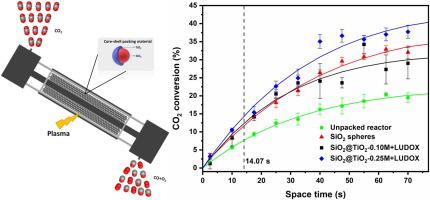Journal of CO2 Utilization ( IF 7.2 ) Pub Date : 2021-02-12 , DOI: 10.1016/j.jcou.2021.101468 Periyasamy Kaliyappan , Andreas Paulus , Jan D’Haen , Pieter Samyn , Yannick Uytdenhouwen , Neda Hafezkhiabani , Annemie Bogaerts , Vera Meynen , Ken Elen , An Hardy , Marlies K. Van Bael

|
Plasma catalysis, a promising technology for conversion of CO2 into value-added chemicals near room temperature, is gaining increasing interest. A dielectric barrier discharge (DBD) plasma has attracted attention due to its simple design and operation at near ambient conditions, ease to implement catalysts in the plasma zone and upscaling ability to industrial applications. To improve its main drawbacks, being relatively low conversion and energy efficiency, a packing material is used in the plasma discharge zone of the reactor, sometimes decorated by a catalytic material. Nevertheless, the extent to which different properties of the packing material influence plasma performance is still largely unexplored and unknown. In this study, the particular effect of synthesis induced differences in the morphology of a TiO2 shell covering a SiO2 core packing material on the plasma conversion of CO2 is studied. TiO2 has been successfully deposited around 1.6–1.8 mm sized SiO2 spheres by means of spray coating, starting from aqueous citratoperoxotitanate(IV) precursors. Parameters such as concentration of the Ti(IV) precursor solutions and addition of a binder were found to affect the shells’ properties and surface morphology and to have a major impact on the CO2 conversion in a packed bed DBD plasma reactor. Core-shell SiO2@TiO2 obtained from 0.25 M citratoperoxotitante(IV) precursors with the addition of a LUDOX binder showed the highest CO2 conversion 37.7% (at a space time of 70 s corresponding to an energy efficiency of 2%) and the highest energy efficiency of 4.8% (at a space time of 2.5 s corresponding to a conversion of 3%).
中文翻译:

使用填充床DBD等离子体反应器探索核壳SiO 2 @TiO 2球的材料性能对等离子体催化CO 2分解的影响
等离子体催化,一种有前途的CO 2转化技术在室温下进入增值化学品领域的兴趣日益浓厚。介电势垒放电(DBD)等离子体由于其在附近环境条件下的简单设计和操作,易于在等离子体区域中实施催化剂以及提高工业应用规模的能力而备受关注。为了改善其主要缺点,即相对较低的转化率和能量效率,在反应器的等离子体放电区中使用填充材料,有时用催化材料装饰。然而,填充材料的不同性能影响等离子体性能的程度仍在很大程度上尚待探索和未知。在这项研究中,合成的特殊作用引起覆盖SiO 2的TiO 2壳的形态差异研究了核芯填料对等离子体CO 2转化的影响。TiO 2已经成功地通过喷涂从大约citratoperoxotitanate(IV)前驱体中沉积了1.6-1.8 mm尺寸的SiO 2球。发现诸如Ti(IV)前体溶液的浓度和粘合剂的添加之类的参数会影响壳的性能和表面形态,并对填充床DBD等离子体反应器中的CO 2转化率产生重大影响。从0.25 M citratoperoxotitante(IV)前体获得的核壳SiO 2 @TiO 2加上LUDOX粘合剂显示出最高的CO 2 转化率为37.7%(在70 s的时空对应于2%的能量效率)和4.8%的最高能量效率(在2.5 s的时空对应于3%的转化率)。











































 京公网安备 11010802027423号
京公网安备 11010802027423号